|
Subscribe
to our
FREE Monthly
e-Newsletter |
|
Click Here |

Have You Ordered Your Book Yet?
Click Here
|

|
Severe obesity is a chronic condition that is very difficult to
treat. Surgery to promote weight loss by restricting food intake
or interrupting digestive processes is an option for severely
obese people. A body mass index (BMI) above 40--which means about
100 pounds of overweight for men and about 80 pounds for
women--indicates that a person is severely obese and therefore a
candidate for surgery . Surgery also may be an option for people with a BMI
between 35 and 40 who suffer from life-threatening cardiopulmonary
problems (for example, severe sleep apnea or obesity-related heart
disease) or diabetes. However, as in other treatments for obesity,
successful results depend mainly on motivation and behavior.
|
|
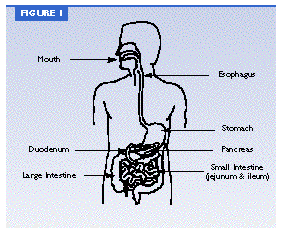 Normally, as food moves along the digestive tract (see figure 1),
appropriate digestive juices and enzymes arrive at the right place
at the right time to digest and absorb calories and nutrients.
After we chew and swallow our food, it moves down the esophagus to
the stomach, where a strong acid continues the digestive process.
The stomach can hold about 3 pints of food at one time. When the
stomach contents move to the duodenum, the first segment of the
small intestine, bile and pancreatic juice speed up digestion.
Most of the iron and calcium in the foods we eat is absorbed in
the duodenum. The jejunum and ileum, the remaining two segments of
the nearly 20 feet of small intestine, complete the absorption of
almost all calories and nutrients. The food particles that cannot
be digested in the small intestine are stored in the large
intestine until eliminated.
Normally, as food moves along the digestive tract (see figure 1),
appropriate digestive juices and enzymes arrive at the right place
at the right time to digest and absorb calories and nutrients.
After we chew and swallow our food, it moves down the esophagus to
the stomach, where a strong acid continues the digestive process.
The stomach can hold about 3 pints of food at one time. When the
stomach contents move to the duodenum, the first segment of the
small intestine, bile and pancreatic juice speed up digestion.
Most of the iron and calcium in the foods we eat is absorbed in
the duodenum. The jejunum and ileum, the remaining two segments of
the nearly 20 feet of small intestine, complete the absorption of
almost all calories and nutrients. The food particles that cannot
be digested in the small intestine are stored in the large
intestine until eliminated.
|
|
The concept of gastric surgery to
control obesity grew out of results of operations for cancer or
severe ulcers that removed large portions of the stomach or small
intestine.
Because patients undergoing these procedures tended to lose
weight after surgery, some physicians began to use such operations
to treat severe obesity. The first operation that was widely used
for severe obesity was the intestinal bypass. This operation,
first used 40 years ago, produces weight loss by causing
malabsorption. The idea was that patients could eat large amounts
of food, which would be poorly digested or passed along too fast
for the body to absorb many calories.
The problem with this surgery was that it caused a loss of
essential nutrients and its side effects were unpredictable and
sometimes fatal. The original form of the intestinal bypass
operation is no longer used.
Surgeons now use techniques that produce weight loss primarily
by limiting how much the stomach can hold. These restrictive
procedures are often combined with modified gastric bypass
procedures that somewhat limit calorie and nutrient absorption and
may lead to altered food choices.
Two ways that surgical procedures promote weight loss are:
- By decreasing food intake (restriction). Gastric banding,
gastric bypass, and vertical-banded gastroplasty are surgeries
that limit the amount of food the stomach can hold by closing
off or removing parts of the stomach. These operations also
delay emptying of the stomach (gastric pouch).
- By causing food to be poorly digested and absorbed (malabsorption).
In the gastric bypass procedures, a surgeon makes a direct
connection from the stomach to a lower segment of the small
intestine, bypassing the duodenum, and some of the jejunum.
Although results of operations using these procedures are more
predictable and manageable, side effects persist for some
patients.
|
|
Restriction Operations
Restriction operations are the surgeries most often used for
producing weight loss. Food intake is restricted by creating a
small pouch at the top of the stomach where the food enters from
the esophagus. The pouch initially holds about 1 ounce of food and
expands to 2-3 ounces with time. The pouch's lower outlet usually
has a diameter of about 1/4 inch. The small outlet delays the
emptying of food from the pouch and causes a feeling of fullness.
After an operation, the person usually can eat only a half to a
whole cup of food without discomfort or nausea. Also, food has to
be well chewed. For most people, the ability to eat a large amount
of food at one time is lost, but some patients do return to eating
modest amounts of food without feeling hungry.
Restriction operations for obesity include gastric banding and
vertical banded gastroplasty. Both operations serve only to
restrict food intake. They do not interfere with the normal
digestive process.
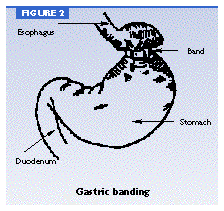
- Gastric banding. In this procedure, a band
made of special material is placed around the stomach near its
upper end, creating a small pouch and a narrow passage into
the larger remainder of the stomach (figure 2). In the future,
it may be possible to perform gastric banding with smaller
incisions through a laparoscope, a flexible fiberoptic tube
and light source through which some surgical instruments may
be passed. Laparoscopic gastric banding has not yet been
approved by the Food and Drug Administration.
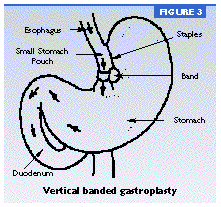
- Vertical banded gastroplasty (VBG). This
procedure is the most frequently used restrictive operation
for weight control. As figure 3 illustrates, both a band and
staples are used to create a small stomach pouch.
Restrictive operations lead to weight loss in almost all patients.
However, weight regain does occur in some patients. About 30
percent of persons undergoing vertical banded gastroplasty achieve
normal weight, and about 80 percent achieve some degree of weight
loss. However, some patients are unable to adjust their eating
habits and fail to lose the desired weight. In all weight-loss
operations, successful results depend on your motivation and
behaviors.
A common risk of restrictive operations is vomiting caused by
the small stomach being overly stretched by food particles that
have not been chewed well. Other risks of VBG include erosion of
the band, breakdown of the staple line, and, in a small number of
cases, leakage of stomach juices into the abdomen. The latter
requires an emergency operation. In a very small number of cases
(less than 1 percent) infection or death from complications can
occur.
Gastric Bypass Operations
These operations combine creation of small stomach pouches to
restrict food intake and construction of bypasses of the duodenum
and other segments of the small intestine to cause malabsorption.
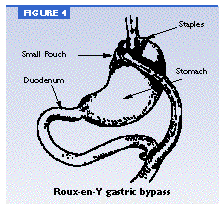
- Roux-en-Y gastric bypass (RGB). This operation
(figure 4) is the most common gastric bypass procedure. First,
a small stomach pouch is created by stapling or by vertical
banding. This causes restriction in food intake. Next, a
Y-shaped section of the small intestine is attached to the
pouch to allow food to bypass the duodenum (the first segment
of the small intestine) as well as the first portion of the
jejunum (the second segment of the small intestine). This
causes reduced calorie and nutrient absorption.
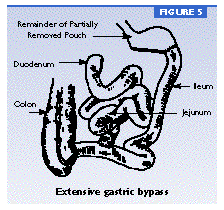
- Extensive gastric bypass (biliopancreatic diversion).
In this more complicated gastric bypass operation (figure 5),
portions of the stomach are removed. The small pouch that
remains is connected directly to the final segment of the
small intestine, thus completely bypassing both the duodenum
and jejunum. Although this procedure successfully promotes
weight loss, it is not widely used because of the high risk
for nutritional deficiencies.
Gastric bypass operations (figures 4 and 5) that cause
malabsorption and restrict food intake produce more weight loss
than restriction operations (figures 2 and 3) that only decrease
food intake. Patients who have bypass operations generally lose
two-thirds of their excess weight within 2 years.
The risks for pouch stretching, band erosion, breakdown of
staple lines, and leakage of stomach contents into the abdomen are
about the same for gastric bypass as for vertical banded
gastroplasty. However, because gastric bypass operations cause
food to skip the duodenum, where most iron and calcium are
absorbed, risks for nutritional deficiencies are higher in these
procedures. Anemia may result from malabsorption of vitamin B12
and iron in menstruating women, and decreased absorption of
calcium may bring on osteoporosis and metabolic bone disease.
Patients are required to take nutritional supplements that usually
prevent these deficiencies.
Gastric bypass operations also may cause "dumping
syndrome," whereby stomach contents move too rapidly through
the small intestine. Symptoms include nausea, weakness, sweating,
faintness, and, occasionally, diarrhea after eating, as well as
the inability to eat sweets without becoming so weak and sweaty
that the patient must lie down until the symptoms pass.
The more extensive the bypass operation, the greater is the
risk for complications and nutritional deficiencies. Patients with
extensive bypasses of the normal digestive process require not
only close monitoring, but also life-long use of special foods and
medications.
|
|
Surgery to produce weight loss is a
serious undertaking. Each individual should clearly understand
what the proposed operation involves. Patients and physicians
should carefully consider the following benefits and risks:
Benefits
- Immediately following surgery, most patients lose weight
rapidly and continue to do so until 18 to 24 months after the
procedure. Although most patients then start to regain some of
their lost weight, few regain it all.
- Surgery improves most obesity-related conditions. For
example, in one study blood sugar levels of most obese
patients with diabetes returned to normal after surgery.
Nearly all patients whose blood sugar levels did not return to
normal were older or had had diabetes for a long time.
Risks
- Ten to 20 percent of patients who have weight-loss
operations require followup operations to correct
complications. Abdominal hernias are the most common
complications requiring followup surgery. Less common
complications include breakdown of the staple line and
stretched stomach outlets.
- More than one-third of obese patients who have gastric
surgery develop gallstones. Gallstones are clumps of
cholesterol and other matter that form in the gallbladder.
During rapid or substantial weight loss a person's risk of
developing gallstones is increased. Gallstones can be
prevented with supplemental bile salts taken for the first 6
months after surgery.
- Nearly 30 percent of patients who have weight-loss surgery
develop nutritional deficiencies such as anemia, osteoporosis,
and metabolic bone disease. These deficiencies can be avoided
if vitamin and mineral intakes are maintained.
- Women of childbearing age should avoid pregnancy until their
weight becomes stable because rapid weight loss and
nutritional deficiencies can harm a developing fetus.
|
Is the Surgery for You?
For patients who remain severely obese
after nonsurgical approaches to weight loss have failed, or for
patients who have an obesity-related disease, surgery may be the
best next step. But for other patients, greater efforts toward
weight control, such as changes in eating habits, behavior
modification, and increasing physical activity, may be more
appropriate. Answers to the following questions may help in your
decision to undergo surgery for weight loss.
Are you:
- unlikely to lose weight successfully with (further)
nonsurgical measures?
- well informed about the surgical procedure and the effects
of treatment?
- determined to lose weight and improve your health?
- aware of how your life may change after the operation
(adjustment to the side effects of the surgery, including need
to chew well and inability to eat large meals)?
- aware of the potential for serious complications, the
associated dietary restrictions, and the occasional failures?
- committed to lifelong medical followup?
Do you:
- have a BMI of 40 or more?
- have an obesity-related physical problem (such as body size
that interferes with employment, walking, or family function)?
- have high-risk obesity-related health problems (such as
severe sleep apnea or obesity-related heart disease)?
Remember: There are no guarantees for any method,
including surgery, to produce and maintain weight loss. Success is
possible only with your fullest cooperation and commitment to
behavioral change and medical followup--and this cooperation and
commitment should be carried out for the rest of your life.
|
|
Gastrointestinal Surgery for
Severe Obesity. Consensus Statement, NIH Consensus
Development Conference, March 25-27, 1991; Public Health Service,
National Institutes of Health, Office of Medical Applications of
Research, Building 1, Room 260, Bethesda, MD 20892. This
publication, written for health professionals, summarizes the
findings of a conference discussing treatments for severe obesity.
Understanding Adult Obesity. NIH Publication No.
94-3680. This fact sheet describes what obesity is, its causes,
how it is measured, and associated health risks. |
|